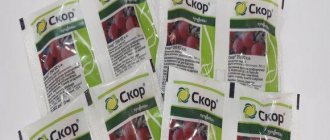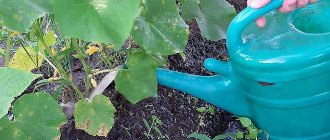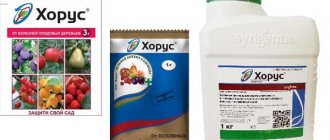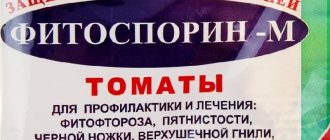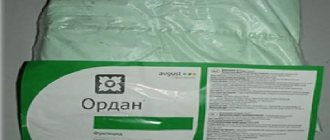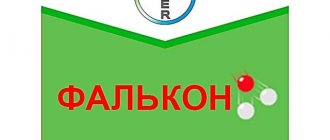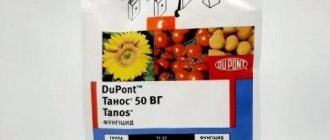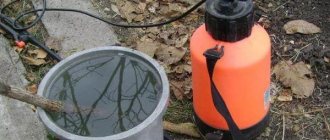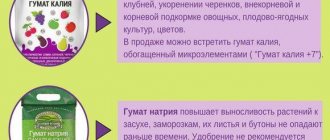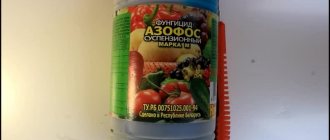Composition, formulation and purpose of the herbicide Glyfor
The drug contains glyphosate, a complex, universal action product. It is available in liquid form; all you have to do is dilute it with water in the required concentration.
Glyfor copes with a wide range of pests:
- Annuals.
- Perennial.
- Cereals.
- Dicotyledonous.
- Dandelions.
- Convolvulus.
- Birch.
- Sow thistle.
By using Glyfor, you can be sure that the weeds will be gone from the area for a long time.
Compound
The drug contains the active substance metformin hydrochloride, as well as auxiliary components: sorbitol, povidone, calcium stearate, stearic acid, polyethylene glycol.
pharmachologic effect
Type 2 diabetes mellitus causes decreased sensitivity to insulin. As a result, an excess amount of this hormone accumulates in the patient’s body. The constant presence of insulin in tissue cells leads to increased glucose levels and organ damage.
In this case, it is important for patients to take medications whose action is aimed at reducing glucose levels. Metformin, which is part of the drug, enhances the absorption and removal of glucose from the body. As a result, sugar levels decrease due to inhibition of sugar formation in liver cells and acceleration of the breakdown of glucose in the body.
Gliformin reduces a person's appetite, which promotes weight loss in patients suffering from excess body weight.
Mechanism of action and speed of action
The effect of Glyfor is based on the following factors: the drug interrupts the development of amino acids in harmful plants, while simultaneously changing the permeability of membranes in cells. These circumstances have a depressing effect on the viability of weeds; they die before our eyes. As a rule, within 3-4 days for annual pests and 10 for perennial pests, the leaves wither and the aerial parts dry out.
Over time, the herbicide travels through the capillaries to the roots, finally destroying the weed.
How to take Gliformin 1000?
This hypoglycemic drug can be used for weight loss. To do this, take half a tablet (0.5 g) twice a day. Using the medicine in large doses leads to poisoning. The course of therapy is 20 days. Then they take a break for a month and repeat the same course. If you take a shorter break, the patient develops adaptation to metformin, and the effectiveness of therapy decreases.
The use of the medicine does not burn fat, but distributes energy in the body.
For diabetes
The dose of this medicine is prescribed individually. It is taken orally. The selection criterion is the glycemic index. The tablet must be taken whole, without chewing. The maintenance dose of metformin is 2 tablets.
It is advisable for elderly people to take 1 tablet of Gliformin 1000.
It is advisable for elderly people to take 1 tablet of Gliformin 1000.
In case of severe metabolic reactions, the dose of this drug is reduced.
How long does it protect?
On average, the drug retains a high concentration in plant tissues for almost 2 months, up to 50 days. All this time there is intensive pumping from the above-ground part of the weed to the underground. With standard processing, mechanical destruction, it is the roots hidden in the depths that pose the greatest danger. The herbicide eliminates this problem once and for all.
See also
Instructions for the use of fungicides for grapes and the best preparationsRead
How does it work and how quickly does it work?
"Glyfor" is considered a universal composition. It can be used to destroy many weeds on the site. The drug is effective against cereals and dicotyledonous annual weeds. It also helps control perennial plants that are difficult to grow. The most harmful weeds include sow thistle, birch, and dandelions.
Expert opinion
Zarechny Maxim Valerievich
Agronomist with 12 years of experience. Our best country expert.
Ask a Question
The drug suppresses the production of aromatic amino acids in weeds and changes the permeability of cell membranes. As a result, the weed loses its viability.
The systemic effect of "Glyfor" helps to cope with all harmful plants that are common in the area. The active component of the product moves through fragments of bushes, moving from above-ground elements to the root system. In this case, the period of protective action of the product lasts 50 days.
See also
Instructions for use and composition of the herbicide Zlakterr, dosage and analogues
Read
On annual weeds, signs of damage appear after 3-4 days. It will take at least 10 days to wait until perennial plants are damaged. First, the leaves on the bushes wither and turn yellow. After which the active substance penetrates the root system, which leads to the death of the weed.
Advantages and disadvantages
To ensure the reliability and high efficiency of the product, consider its advantages:
- It affects all parts of the plant, equally inhibiting leaves, stems, and roots.
- Recommended for a wide range of garden pests.
- It is not washed out of the weed tissue even in the rain.
- Decomposition in the soil occurs quickly; traces of the chemical do not penetrate into cultivated plants.
- Already 7 days after the dressing, sowing of seeds and planting of seedlings is allowed.
- By type of action it is classified as a desiccant - a substance that inhibits the underground part of the weed.
- The shelf life is 5 years.
Among the shortcomings, one can highlight one, but a serious one: Glyfor is a herbicide, a poison that poses a danger to humans. Handling it requires precautions.
Tips for use
Before you start giving advice on using the drug, it is important to note its advantages, and these are what experts and gardeners call:
- The composition acts quickly and, most importantly, reliably in the fight against weeds.
- Destroys almost all groups and types of weeds.
- 2-3 hours after spraying, the composition cannot be washed off, even if it rains heavily.
- It does not accumulate in plants due to the fact that it quickly decomposes in the soil.
- Already after a week from the day of spraying, seedlings can be planted in the ground or seeds can be sown.
- It is convenient to use and classified as hazard class 3, therefore it poses a moderate danger to humans and animals.
- It has a long shelf life from the date of release - 5 years.
Using Glyfor against weeds according to the instructions allows you to significantly increase the effectiveness of the drug, obtaining the desired result in the form of destruction of weeds. Glifor itself can be successfully used both in summer cottages and when cultivating large-area crop fields and gardens.
In order for the product to work and bring the desired effect on weeds, it is important to take into account a number of important points:
- The herbicide itself is used only for spraying the green mass of weeds and not in the form of watering at the root. The thing is that root watering and processing of the soil itself will not have the desired result.
- The Glyfor solution prepared for spraying sits for 24 hours - after this time the solution loses its properties.
- During the spraying process, it is important to protect and protect useful cultural plantings from the damaging effects of the herbicide. In this case, the plants should be covered or otherwise protected from the solution getting on them.
- Spraying should be carried out in sunny weather, when there is no heavy dew - in this case, the composition is simply washed off from the greenery and has no effect.
- If precipitation is predicted in the next 6–7 hours, you should temporarily postpone spraying the weeds.
- Spray weeds at moderate air humidity, average temperatures - 16–22 degrees, on a dry and sunny day.
- To ensure that the sprayed composition itself is not blown away by the wind from the treated weed, you should not spray on a windy day when the wind gust speed is more than 5 m/s.
How to get rid of pests: Insecticide Karbofos - use in the garden.
Read about the use of Previkur Energy fungicide in this article.
Important information about fertilizing plants with microelements:
Consumption measures for different plants
Depending on the type of crop, the concentration of the plant treatment agent varies. Spring crops, potatoes, and vegetables must be sprayed according to the following scheme: 80 milliliters of Glyfor for annuals and 100 milliliters for perennial weeds. The dose of the drug is diluted in a bucket (10 liters) of water.
The optimal time for etching is autumn.
Gardens and vineyards are treated according to a similar principle: they are sprayed in the summer at the rate of 80/120 milliliters for annual/perennial pests. The same is done with areas that are planned to be prepared for sowing next year (or after harvest).
Instructions for use
How to breed Glyfor:
- To treat the soil against annual weeds, 80 ml of the drug is diluted in 10 liters of water.
- To destroy perennial weeds, 120 ml of Glyphos is dissolved in 10 liters of water.
In accordance with the instructions, the method and time of treatment, restrictions on the use of the weed killer Glyfor are as follows:
- When directly sprayed during the growing season in the spring and summer months, provided that the useful crop is protected. In this case, the average consumption of the working solution is 5 liters per 100 square meters.
- Carrying out the main spraying at the stage of active vegetation during the period after harvesting - in this case, the average consumption of working fluid is per 100 square meters of cultivated area.
In practice, in accordance with the instructions supplied by the developers, there are a variety of ways to use the drug, taking into account the culture.
On annual crops, the following scheme for processing wild herbs is used:
- Before sowing, the fields are treated to subsequently prevent the appearance of weeds, reduce the number of weeds and remove them mechanically.
- Carrying out early treatment after sowing, before the first shoots appear.
- Carrying out pre-harvest treatment in the fields will allow desiccation of the weed itself and the crop.
- After the actual harvesting, this will prevent the germination of perennial weeds in the areas.
The composition is also used for perennial crops growing in gardens and vineyards. This will not only reduce the number of wild grasses, but also maintain a sufficient level of soil moisture and reduce the number of mechanical cultivations. In this case, the herbicide can be used without the risk of affecting the trunk of the useful garden crop itself.
How to properly prepare and use the working solution
The mixture is prepared immediately before use. If there are cultivated plants near the treatment area, it is advisable to cover them with film and isolate them during spraying. The required dose of the product, depending on the etching scheme, is diluted in a bucket of water.
Spraying occurs optimally quickly and reliably using a garden sprayer. Only the green parts (stem, leaves) are processed; there is no need to water the roots. The prepared Glyfor solution is not intended for long-term storage; it should be used as quickly as possible.
See also
Instructions for use of Topsin M fungicide and mechanism of actionRead
Side effects of Gliformin 1000
If the dosage and administration regimen is violated, various side effects are possible.
Gastrointestinal tract
The appearance of nausea and vomiting. Patients may be bothered by a strong, unpleasant metallic taste in the mouth. Sometimes taking Gliformin leads to a sharp drop in appetite and flatulence.
These symptoms can be reduced with the help of antacids and antispasmodics.
Metabolism
Metformin may cause malabsorption of vitamin B12 (cyanocobalamin).
In rare cases, it causes lactic acidosis. This condition requires cessation of treatment.
From the endocrine system
The most common side effect of metformin, especially at the beginning of treatment, is hypoglycemia. It begins suddenly and is characterized by pallor, anxiety, cold sweat, and confusion. In the initial period of its development, the patient can stop this condition by consuming a small amount of sweets.
Impact on the ability to operate machinery
Because the medication can cause hypoglycemia; during treatment, persons with a tendency to sharply decrease blood glucose levels should not drive a car or operate complex machinery.
Precautions when working with the product
Glyfor belongs to hazard class 3 (moderate). Translated into Russian, this means that it is difficult to get poisoned by the drug, but it is also not advisable to allow it to get into the organs of vision, the esophagus, or the mucous membranes. In this case, it is necessary to immediately rinse the affected organ or area with warm water.
If swallowed, induce vomiting or consult a doctor immediately. When performing spraying, use special clothing, rubber gloves and a mask, as well as safety glasses.
Precautionary measures
Despite the low hazard class of Glyfor, when using it it is worth remembering the rules of use and personal safety. You should act according to the instructions, which include a number of points:
- If you need to transport or transfer the drug or a solution created on its basis, you should do this in a hermetically sealed container.
- Before the procedure, you must familiarize yourself with the information about the rate of consumption, concentration, frequency of use according to the instructions.
- The weed control solution must not be prepared in a container used for other purposes.
- Neighbors should be warned about the upcoming treatment if their site is in close proximity.
- It is prohibited to allow children, teenagers, pregnant and lactating women, and patients to work with the herbicide.
- Before work, check the serviceability of the sprayer using water.
- To process weeds, you need to prepare protective clothing, a hat, a rubber apron, gloves, and boots.
- To protect your respiratory system and eyesight, you should use a respirator or gauze bandage and safety glasses.
- People around you should be warned about the treatment being carried out so that they do not pick fruits in the garden during this period and do not pick up the grass until, according to the instructions, the active substance has completely decomposed.
- While working with Glyfor, it is forbidden to eat or smoke so that toxins do not enter the body.
- If there is an apiary on the site, spraying should be carried out at the moment when the bees are in the hives.
- After work, clothes must be removed, hands and face washed with soap.
- Glyfor is stored away from food, out of the reach of children and animals, in a tightly closed container.
- After use, the container is disposed of.
Important! If the solution gets into your eyes, you should immediately rinse them under running water.
With strict adherence to precautions, according to the instructions, processing is not difficult even for a beginner.
Applications and dosages
The required frequency of administration is determined by the treating specialist based on the patient’s clinical picture. It is prohibited to violate the dosage instructions and other aspects of taking Gliformin.
for adults
The initial dose of the medication is 0.5-1g/day or 0.85g 1 time/day. After 10-15 days, a gradual increase in dosage is possible, subject to glycemic monitoring. The maintenance dose of the medication is often 1.5-2 g/day. The highest daily dose is 3 g/day. To reduce the number of adverse reactions, it is advisable to divide the daily dose into 2-3 doses.
In elderly patients, the maximum daily dose should not be more than 1 g. In severe metabolic disorders, the dose should be reduced due to the increased likelihood of lactic acidosis.
Gliformin is taken during or after a meal, the tablet is not chewed and is washed down with a significant amount of liquid.
for children
The medication is not used in childhood. Use of the drug under 18 years of age is allowed only in cases of urgent need and after the child has passed all the required tests.
for pregnant women and during lactation
In case of planning pregnancy and during conception, it is necessary to abandon Gliformin and replace it with insulin therapy. If it is necessary to use Giformin during lactation, it is necessary to stop feeding the baby with breast milk, since there is no information regarding the excretion of metformin with milk.
GLYFOR, BP (360g/l). Herbicide. Description, sale
- Manufacturer: Kirovo-Chepetsk Chemical Company
- Preparative form: aqueous solution (VR)
- Active ingredient: glyphosate (isopropylamine salt)
- Active concentration: 360 g/l glyphosate content
- Chemical class of active substance: glycine derivatives
- Packaging: 20l canister
A general exterminating herbicide for the control of harmful vegetation in agriculture, forestry and public utilities.
Peculiarities
- High-tech systemic herbicide with continuous action. Desiccant.
- Fast action and high reliability.
- Almost complete destruction of all types of weeds.
- Use in both spring and autumn.
- It is not washed off by precipitation 2-3 hours after spraying.
- Sowing of crops is possible from 2 - 5 days to 2 weeks after treatment.
- Rapid decomposition in the soil, no residues in the crop.
- Compatible with most pesticides used.
- Convenience and ease of use, safety for personnel.
Purpose
A general exterminating herbicide for the control of harmful vegetation in agriculture, forestry and public utilities.
Desiccant, i.e. a preparation intended for drying standing plants.
Period of protective action
Apply once a season, protective effect 50 days before the second wave of weeds appears.
Impact speed
The effect of the drug becomes noticeable on annual weeds after 2-4 days, on perennials - after 10 or more days. Signs of the drug’s action are gradual wilting, yellowing, and then browning of the leaves.
Mechanism of action
Glyfor® blocks the synthesis of aromatic amino acids and affects the permeability of cell membranes, which leads to changes in osmotic pressure and, ultimately, to the destruction of cellular structures.
It has a systemic effect and is able to move throughout the plant, getting from the above-ground part to the roots. It is used in fields intended for sowing corn, spring grain and vegetable crops, etc.
It is also used for pre-harvest treatment of grain crops to dry the grain and partially suppress the growth of weeds.
Regulations for the use of the herbicide Glyfor, VR
Culture Consumption rate, l, kg/ha Harmful object Method, treatment time, application features Waiting period (frequency of treatments) Release time for manual. (mechanical) works
| Fruit, citrus crops, vineyards | 2-4 | Annual cereals and dicotyledonous weeds | Spraying of vegetative weeds in spring or summer (provided the crop is protected). Working fluid consumption - 100-200 l/ha | -(1) | -(-) |
| Fruit and citrus crops | 4-8 | Perennial cereal and dicotyledonous weeds | |||
| Vineyards | 4 | Spraying of perennial cereals and dicotyledonous vegetative weeds in May-July (subject to crop protection). Working fluid consumption - 100-200 l/ha | -(2) | ||
| Sugar beet, corn | 2-5 | Annual and perennial, incl. wheatgrass, weeds | Spraying vegetative weeds 2 weeks before sowing. Working fluid consumption - 100-200 l/ha | -(1) | |
| Potato | 2-3 | Spraying vegetative weeds 2-5 days before crop emergence. Working fluid consumption -100-200 l/ha | |||
| Sunflower, cabbage, soybeans | 2-3 | Annual and perennial dicotyledonous and cereal weeds | Spraying vegetative weeds 2-5 days before sowing (planting) the crop. Working fluid consumption - 100-200 l/ha | -(1) | -(-) |
| Fields intended for sowing various crops (spring grains, vegetables, potatoes, industrial, oilseeds, melons), as well as annual flowers (seed crops) | 2-4 | Annual cereals and dicotyledonous weeds | Spraying vegetative weeds in the fall during the post-harvest period. Working fluid consumption - 100-200 l/ha | ||
| 4-6 | Perennial cereal and dicotyledonous weeds | ||||
| 6-8 | Perennial weeds (pigweed, field bindweed, field thistle, etc.) | ||||
| Couples | 2-4 | Annual cereals and dicotyledonous weeds | Spraying weeds during their active growth period. Working fluid consumption - 100-200 l/ha | ||
| 4-6 | Perennial cereal and dicotyledonous weeds | ||||
| 6-8 | Perennial weeds (pigweed, field bindweed, field thistle, etc.) | ||||
| Fields intended for seed crops of perennial cereal grasses | 4-8 | Perennial, annual cereal and dicotyledonous weeds | Spraying of vegetative weeds in the post-harvest period or in the spring 2-4 weeks before sowing herbs. Working fluid consumption - 100-200 l/ha | ||
| Alfalfa | 0,6-0,8 | Thin-stemmed dodder | Spraying crops 7-10 days after mowing. Working fluid consumption -100-200 l/ha | ||
| Non-agricultural lands (protected zones of power lines and clearings, gas and oil pipeline routes, embankments and rights-of-way of railways and highways, airfields and other industrial areas) | 3-6 | All types of undesirable herbaceous plants (with the exception of relatively resistant reed grass, reeds, etc.), deciduous trees and shrubs (aspen, birch, alder) | Spraying weeds in June-September during the period of their active growth. Working fluid consumption is 100-200 l/ha. It is prohibited for people to stay in the treated areas, incl. for picking mushrooms and berries, within 15 days | ||
| 6-8 | Relatively stable undesirable herbaceous plants (reed grass, reeds, etc.), deciduous trees and shrubs (willow, maple, ash, elm, acacia, etc.) | ||||
| Fruit, citrus crops, vineyards | 80 ml/10 l water (L) | Annual cereals and dicotyledonous weeds | Directed spraying of vegetative weeds in spring or summer, subject to crop protection. Working fluid consumption is 5 l/100 m2. The period of possible stay of people in the treated areas is no earlier than 15 days after treatment | -(1) | 15(15) |
| 120 ml/10 l water (L) | Perennial cereal and dicotyledonous weeds | ||||
| Areas intended for sowing various crops (vegetables, potatoes, legumes, industrial, oilseeds, melons, berries, lawns, flowers and ornamentals) | 80 ml/10 l water (L) | Annual cereals and dicotyledonous weeds | Spraying vegetative weeds in the fall during the post-harvest period. Working fluid consumption is 5 l/100 m2. The period of possible stay of people in the treated areas is no earlier than 15 days after treatment | ||
| 120 ml/10 l water (L) | Perennial cereal and dicotyledonous weeds | ||||
| Areas not intended for sowing or planting cultivated plants (roadsides, along fences, buildings) | 80 ml/10 l water (L) | Annual cereals and dicotyledonous weeds | Spraying vegetative weeds in the fall during the post-harvest period. Working fluid consumption is 5 l/100 m2. The period of possible stay of people in the treated areas is no earlier than 15 days after treatment | -(1) | 15(15) |
| 120 ml/10 l water (L) | Perennial cereal and dicotyledonous weeds |
Regulations for the use of the drug Glifor, VR as a desiccant
Culture Consumption rate, l, kg/ha Harmful object Method, treatment time, application features Waiting period (frequency of treatments) Release time for manual. (mechanical) works
| Cereals | 2-3 | Desiccation | Spraying crops 2 weeks before harvesting (with grain moisture content not exceeding 30%) to dry the grain and partially suppress weeds. Working fluid consumption - 100-200 l/ha | -(1) | -(-) |
| Fiber flax | Spraying weeds 28 days before harvesting to dry out crops and weeds. Working fluid consumption - 100-200 l/ha | ||||
| Fiber flax (commercial crops) | 2,5 | Spraying 10 days after the end of flowering when infested with annual weeds. Working fluid consumption - 100-200 l/ha | |||
| Sunflower | 2-3 | Spraying crops 10 days before harvesting (with grain moisture content not exceeding 30%) to dry cultivated and weed plants. Working fluid consumption -100-200 l/ha; during aerial treatment - 50-100 l/ha | |||
| 2-3 (A) |
- Registrant: Kirovo-Chepetsk Chemical Company LLC
- Registration number: 1542-09-108(110)-223-0-0-3-1
- Registration closing date: 05/21/2019
- Mammalian hazard class: 3
- Bee hazard class: 3
- There are no restrictions on use in the sanitary zone around fishery reservoirs
Source: https://tk9.ru/catalog/szr/desikanty-i-gerbicidy-sploshnogo-deystviya/glifor-vr-360gl-kchhk-20l-20-40-sploshnogo-deystviya/
Akzifor. Buy herbicide Akzifor, manufacturer's price
The Akzifor herbicide has two methods of application - it can be used to treat the soil before sunflower germination, as well as for spraying young onion plantings. The drug effectively destroys all dicotyledonous young weeds in a short time (up to 4 days).
Preparative form of the herbicide Akzifor:
EC – emulsion concentrate
Active ingredient of the herbicide Akzifor:
Substance from the class of nitrophenol derivatives – Oxyfluorfen (240 g/l)
Purpose of the herbicide Akzifor:
It is used to destroy dicotyledonous weeds before sunflower emergence and in planting young onion plants.
Weeds that Akzifor destroys
:
Active against small-flowered galinsoga, artemisia ragweed, black nightshade, field mustard, tenacious bedstraw, theophrastus, bindweed, chamomile and inodorous, common gum, white goosefoot, upturned acorn, smokeweed, knotweed, bindweed, purslane, cocklebur enny, akalifa southern, Tartary buckwheat, middle chickweed, hemp weed, milkweed-sunflower, common groundsel, common pickleweed, wild radish and other young broadleaf weeds.
List of crops on which the herbicide Akzifor is used and application rates:
For sunflower – 0.8-1 l/ha;
For onions (excluding greens) - from 0.5 l/ha (phase of formation of 2 leaves in a crop) to 1 l/ha (phase of formation of 3 leaves in a crop).
The consumption of the prepared solution is 200-300 l/ha.
The mechanism of action of the drug Axifor:
The drug affects all organs of weeds due to its contact-systemic properties. Axifor suppresses the production of energy inside weeds by suppressing and disrupting the formation of carotenoids, chlorophyll, ATP, RNA, etc. As a result, the weeds become discolored, various yellow, black and brown spots appear on the leaves, which leads to drying.
The preparation is sprayed on the soil after sowing sunflowers (before germination), as well as onions during the period of formation of 2 to 3 leaves. During the growing season, one treatment is carried out.
Advantages and features of the herbicide Akzifor:
complete destruction of weeds within 4 days;
can be used in planting onions of different years of cultivation;
long-term protective effect ensures long-term, uncompetitive growth of cultivated plants;
non-toxic to plants;
does not cause resistance;
high efficiency even at low temperatures;
a wide range of effects on weedy young dicotyledonous vegetation;
safe for people and animals;
does not affect soil fertility, because is not released in the soil;
rapid decomposition in the soil protects even very sensitive crop rotation crops from the toxic effects of the drug;
not dangerous for bees and entomophages.
Duration of the protective action of the herbicide Akzifor:
Keeps for 3 weeks.
Compatibility of the herbicide Akzifor with pesticides:
Compatible with other herbicides in tank mixtures.
Hazard class of the herbicide Akzifor:
Has the third (III) hazard class for humans and beneficial organisms (low hazard).
Storage of herbicide Akzifor:
Glyphosate as a desiccant
Glyphosate can be used as a desiccant. Desiccation is carried out to get rid of excess moisture. This procedure is especially common in rainy regions of our planet; in Russia, desiccation has been practiced for the last 20 years. Typically, crops such as sunflower, rapeseed, cotton, peas, potatoes, etc. are subject to desiccation.
This procedure makes harvesting easier. Glyphosates are used less frequently for this procedure than diquat-based products. The effect of diquat-based drugs is milder.
Sources
- https://dizajn-sada.ru/uxod-za-sadom/borba-s-vreditelyami/udalit-vse-sornyaki-pomozhet-glifos/
- https://7dach.ru/VeraTyukaeva/raundap—klony-s-raznymi-nazvaniyami-118229.html
- https://fermilon.ru/sad-i-ogorod/sornyaki/gerbitsid-glifos.html
- https://udobreniya.pro/glifosat-gerbicid-instrukcya-po-primeneniyu-otzyvy-kogda-obrabatyvat-vred-dlya-cheloveka/
- https://nasotke.pro/ogorod/glifosat-ot-sornyakov
- https://agronomu.com/bok/4727-gerbicid-glifos-instrukciya-po-primeneniyu.html
- https://my-agro.com/gerbitsid-glifosat
- https://sornyakov.net/tips/glifosat.html
Instructions for use
The dosage should be selected by a doctor, taking into account the individual characteristics of the patient.
Most often, at the beginning of treatment, it is recommended to consume 0.5-1 g per day. After about two weeks, the dosage can be increased. The maximum amount of active substance should not exceed 3 g.
For maintenance therapy, it is recommended to take 1.5-2 g of the drug. This amount should be divided into several doses.
Older adults, especially those whose level of physical activity is very high, should not take more than 1 g per day.
The schedule for taking Gliformin depends on many indicators, so the doctor should monitor changes in sugar levels. If necessary, the dose is adjusted to achieve better results. If there are changes in the patient's lifestyle, the dosage should also be reconsidered.
These tablets should be taken during a meal or immediately after it. There is no need to crush or chew them - they are swallowed whole with water.
The duration of the treatment course may vary. In the absence of side effects and high efficiency, this drug can be taken for a very long time. If negative symptoms are detected, it is advisable to use substitutes so as not to worsen the patient’s condition.
On the toxicity and compatibility of the herbicide with other types of drugs
Bazagran has been tested for compatibility with other pesticides. These studies showed positive results in the production of combined solutions. Good interaction was noted between the drugs Bazagran and Pivot, as well as with the drug Pulsar 40.
If you follow all the rules for manufacturing and applying the drug, then it is absolutely safe for honey plants, people and animals. Toxicity manifests itself in relation to representatives of aquatic fauna. Because of this, the herbicide is not recommended for use near fishing farms and reservoirs. Avoid empty containers getting into the water. For the safety of the aquatic fauna environment, it is recommended to use the herbicide at a distance of at least 500 m (ideally up to 2 km).
Bazagran herbicide is excellent for those who want to get rid of dicotyledonous weeds in one application. It copes well with weeds without harming crops, people and honey plants. A positive aspect of use is that the herbicide is compatible with other types of drugs. This makes it possible to obtain combined solutions with greater efficiency.
What mineral fertilizer did you use?
Poll Options are limited because JavaScript is disabled in your browser.
You can select multiple answers or enter your own.
When not to use the product
It is not recommended to use the product in the following cases:
- If the cultivated plants were planted very early.
- If the seedlings have been damaged by frost.
- In beds with plants that do not respond well to herbicides.
- In areas with few weeds. In such cases, it is better to simply weed out the weeds or mulch the soil.
- Do not use the drug without protective clothing, glasses and a mask, rubber boots and gloves.
In addition, while using the drug, you should never eat or smoke. During food intake, harmful substances can easily enter the body.
Review: Herbicide Kirovo-Chepetsk chemical - ambiguous
“Glyfor” is a continuous, that is, non-selective herbicide; in other words, it kills all plants, without distinguishing between right and wrong. It is produced under this name by a domestic manufacturer. Also known as Hurricane, Roundup and Tornado. The active ingredient is the same - glyphosate in the form of an aqueous solution - so there is no difference, even the concentration is the same for everyone. I usually buy what is in stock.
The herbicide acts systemically, namely, once it enters the plant through the leaf surface, it moves all the way to the roots, blocking the synthesis of amino acids. As a result, the weeds die. The effect is especially effective on creeping weeds. Naturally, the “dose” should be enough for the entire plant.
Since a person has either lost the ability to photosynthesize, or has not yet mastered this useful skill and receives the above-mentioned amino acids from food, and does not synthesize them, “Glyfor” is not able to harm him.
I Kills, as already noted, all living things involved in photosynthesis. There are no resistant species, that is, resistant to the herbicide. Only GMO. Larger plants and those with a supply of nutrients are better tolerated.
II Soluble in water.
III Absorbs in 2-3 hours.
IV Does not affect seeds and loses activity in the soil.
• You can follow the manufacturer's advice and completely treat the purchased area. Although you can plow with a tractor.
• But trying to destroy weeds after harvesting, as recommended, in my opinion, is wrong. In general, in my opinion, it is better to use the herbicide at the beginning of the growing season.
Read also: Mulberry grafting: how and why, Gardeners
• Under no circumstances should it be used to destroy the growth of garden crops.
• From points II and III we can conclude that before using Glyfor, you should familiarize yourself with the weather forecast: rain in the first couple of hours after treatment will literally wash away all your hard work. But it is clear how to save cultivated plants if they accidentally fall under distribution: just add water.
• Point IV says that crops can be treated before emergence. For example, carrot seeds do not germinate quickly, especially granulated ones; the sprouts are very small and difficult to weed. Cover the bed after sowing with plastic film or covering material. We water the weeds that come out after a few days with a deadly potion. A week later we admire the perfect carrot shoots.
And we must not forget that physical activity in the fresh air - crawling on your knees and swinging a hoe - is recreation, only active, and it has a beneficial effect on our health. But with all this chemistry, everything is not so simple.
Glyphosate was invented by the world-hated American chemical company Monsanto in 1970. New, yes.
The one that is currently the leader in GMO production. In the 60s of the last century, these people produced and supplied the notorious Agent Orange to Vietnam. Perhaps for this reason, people sometimes write on the Internet about a terrible threat to human health from the hero of this review, apparently confusing a relatively harmless product of only the 3rd hazard class with dioxin, a quarter of a million times more poisonous. To take Glyfor, you need to take about a dozen of these 100-gram bottles with convenient measuring divisions orally.
They write that the herbicide does not have a cumulative effect, that is, it does not accumulate in soil, water and the human body, but on the contrary, in nature it quickly loses activity and breaks down into ordinary, harmless substances. Just last year, one of the WHO divisions hinted that glyphosate may be a human carcinogen. It seems that the unfortunate laboratory mice got sick from it. Of course, if you put on a tin foil hat, you can easily imagine how the villains from Monsanto silenced all researchers for almost half a century.
More details about my thoughts on how and where to use Glyfor, based on personal experience, can be found in my reviews of Tornado and Roundup. I do this with caution, as a last resort. Suddenly, it really is a carcinogen.
In fact, this is the most popular herbicide. Including municipal authorities. I want the city flower beds to be beautiful, without weeds. And in agriculture it is used just before harvesting grains as a desiccant, that is, to dry them.
Glyfor weed killer
Owners of small plots most often cope with weeds on their own. Weeding, loosening, mulching - 3 stages were carried out and for a while you can forget about the formidable weeds. But what if you don’t even have 10 acres, but more? In such areas, weeding will be a daily tedious task. Chemicals - herbicides - come to the aid of gardeners. The name of the drugs comes from two Latin words: “herba” - grass and “caedo” - to kill. Therefore, these substances destroy grass or vegetation.
Herbicides are classified according to the nature of their action. They are:
- Selective or selective action. These herbicides act selectively, killing certain types of plants and not harming others. Excellent for use in summer cottages.
- Full action. Destroy vegetation of any kind in the entire area where they are used. They are used in the development of new lands and around industrial facilities.
Glyfor is considered a popular continuous herbicide among gardeners.
Using Glyfor allows you to clear your garden of all types of weeds at minimal cost.
Many gardeners are afraid to use the herbicide "Glyfor" on their plots because of the toxicity of the active substance - 360 g/l glyphosate acid. However, proper use and strict adherence to the instructions will minimize possible problems.
Therefore, in the first days after using Glyfor, do not allow pets to be in the treated area.
